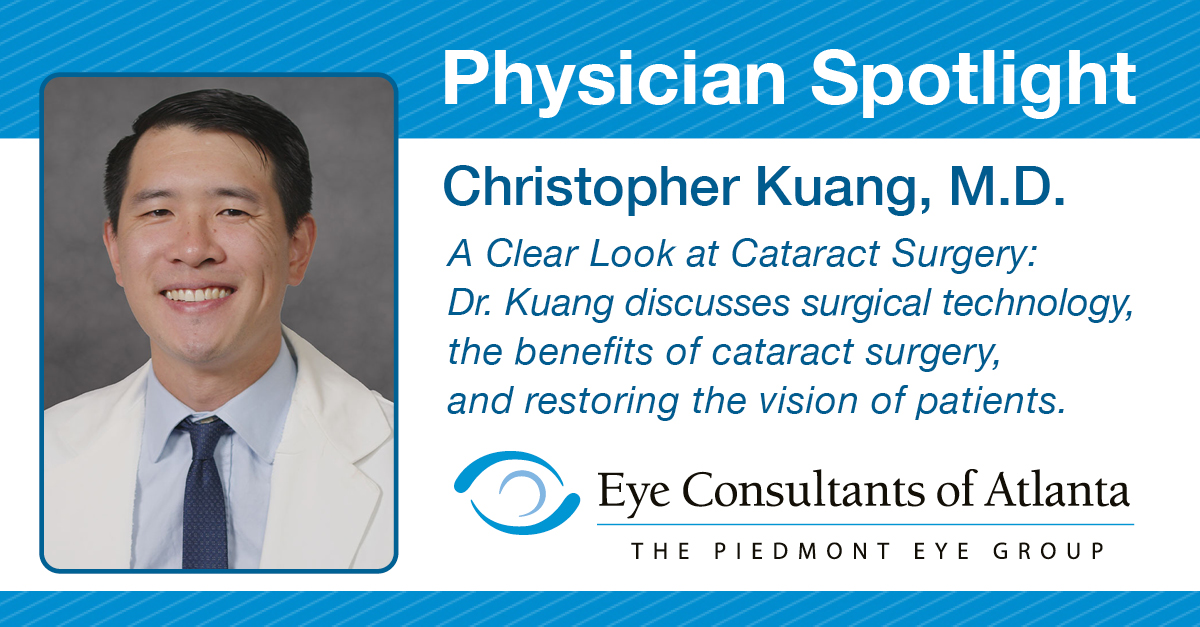For many, cataracts are an unfortunate fact of life. More than half of Americans will develop visually significant cataracts by the age of 80.
A cataract can be defined as a cloudy lens. When the fibers and proteins in a lens break down and clump together, due to aging or a specific medical condition, a cataract is formed. If the cataract is untreated and grows, the clouding will worsen.
In addition to cloudy or blurry vision, patients may complain about symptoms including increased sensitivity to light, poor night vision, trouble reading, yellowing and dimming of colors, and frequent eyeglass prescription changes. What may begin as an annoyance can eventually hinder one’s quality of life.
Thankfully, those suffering from cataracts have a solution. While early-stage cataracts can be managed in non-surgical ways, cataract surgery is the only way to permanently treat vision loss from cataracts. Cataract surgery is a procedure designed to delicately remove the eye’s cloudy lens, often replacing it with a sophisticated artificial lens for improved vision.
Eye Consultants of Atlanta cataract surgeons, such as Dr. Christopher Kuang, can guide patients in the right direction and determine if surgery is the right fit.
Dr. Kuang recently answered a few questions about surgical technology, the many benefits of cataract surgery, and the gratifying experience of restoring the vision of patients.
Question: What are your thoughts regarding the current technology available for cataract surgery?
Dr. Kuang: I would say cataract surgery itself is a relatively mature surgery and has been for many years. We can perform it with a high degree of safety and efficacy with our current instruments. However, it’s also an area with constant innovation. We’re always coming up with even safer, even faster, even better ways to do the same surgery just because it’s something that more and more people are getting into the age group where they need it. So, we need to be able to do these procedures even more effectively than we have been. In short, cataract surgery is already a safe and established surgery with many benefits that we still try to improve on every day.
Q: Can you elaborate on some of the more recent innovations in the surgical process and technology?
Dr. Kuang: Cataract surgery involves removing the cataract, which is the natural lens of the eye, and replacing it with an artificial lens. Artificial lens implantation is an important and routine part of every surgery. In terms of the patient experience, there are different types of lenses that have different applications and suit different lifestyles. The standard lens is an excellent lens that helps you see best at longer distances such as driving or watching television, though you will still require reading glasses for near vision. There are also other lenses that can help you see well up close, far away, and also at intermediate distances such as while working on a computer. Artificial lens technology is an area of constant research and improvement for patients.
Q.: Do you have any inspiring patient success stories?
Dr. Kuang: I’m touched in different ways by the outcomes of each and every patient because every patient’s lives and needs are unique. Some people with mature cataracts who have lost the ability to see colors and shapes in that eye can regain the ability to read and drive. Patients with less severe visual impairment are still often impressed by how bright the colors are and how sharp the clarity is after they’ve grown used to decades of looking through their old cataracts. For quality of life, improving vision can make the simple things more enjoyable, whether it’s reading, watching television, going for a walk, or working on hobbies. Elderly patients often express how excited they are to see their grandchildren’s faces clearly again after cataract surgery. We have countless stories of people who are happy and appreciative after surgery, each one special in their own way.
Q: Cataract surgeries have compounding benefits, right? For example, cataract treatment can prevent injuries from falls because elderly patients who wear bifocal or multifocal glasses often have contrast sensitivity and depth perception issues.
Dr. Kuang: That’s definitely true. It’s all about safety and quality of life, and there are many additional benefits apart from better vision. When it comes to driving, cataract surgery can reduce anxiety by making it easier and safer to drive at night. There’s also research that suggests cataract removal lessens the risk of dementia. Helping people see more clearly allows them to better interact with the world and certainly enhances overall health.
Q.: What’s the most rewarding aspect of performing cataract surgery?
Dr. Kuang: I think we have the best job in the world. We trained so hard for so long as medical students and then as resident physicians, and now we get to see the payoff every week. Being able to take people who aren’t seeing well and improve their vision is a constant gratification for me. There’s no better feeling than the day after surgery when you have patients come in who are doing well and enjoying their new eyes. It’s incredibly rewarding.

